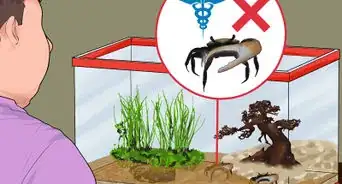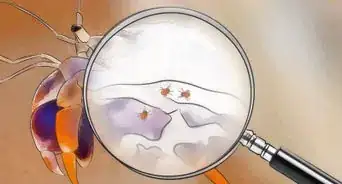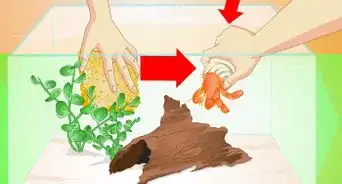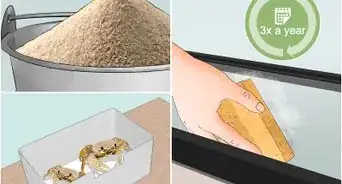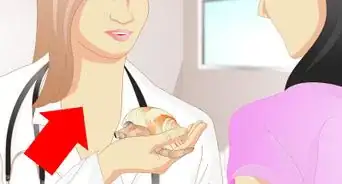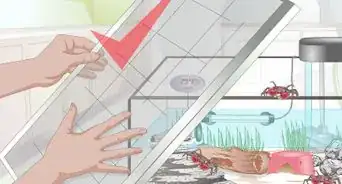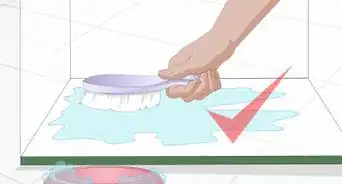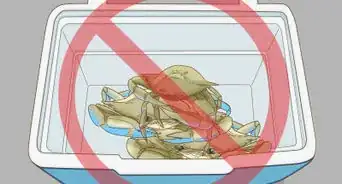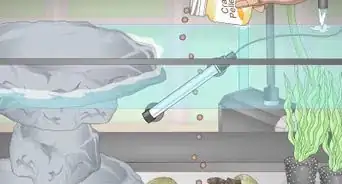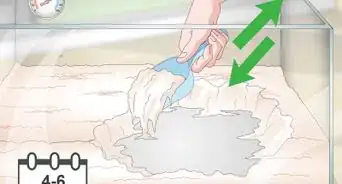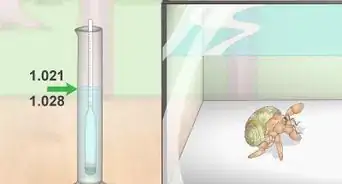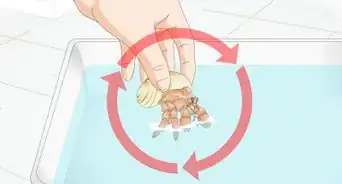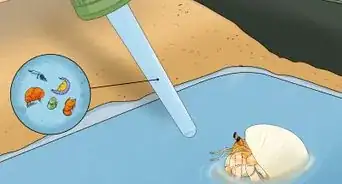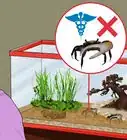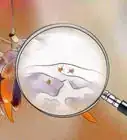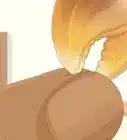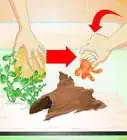This article was co-authored by Marshall Stephens. Marshall Stephens is an Aquarium Expert at Private Oceans Aquariums in West Palm Beach, Florida. Marshall has over 20 years of experience in the aquarium industry and focuses on captive-bred animals. They specialize in tropical and marine aquariums and are a contributor to the Loggerhead Marine life center in Jupiter Florida.
This article has been viewed 37,045 times.
Purple pinchers are the most common type of hermit crab and can be found in pet stores worldwide. They are relatively easy to care for, and can live as many as 10–20 years in captivity.[1] Begin caring for your hermit crab by purchasing and setting up a glass tank complete with water, substrate, and plants. Any large pet store should have all of the items you’ll need to care for and feed your purple pincher hermit crab.
Steps
Setting up a Tank
-
1Obtain a glass 10–20 US gal (38–76 L) tank. This is a great starter size for someone relatively new to owning crabs.[2] These tanks are relatively inexpensive. At most pet stores, 10 gallon (37.9 L) tanks cost about $13 USD and 20 US gal (76 L) tanks run closer to $30 USD. Avoid buying tank-building starter kits at pet stores, because they don't hold humidity in.
- Hermit crabs love to climb and have a knack for escaping their tanks. So, make sure that the tank you purchase comes with a lid, and keep the lid tightly shut once the crabs are inside!
-
2Purchase at least 3-4 hermit crabs. Purple pincher hermit crabs are social animals and don’t do well in isolation. Never purchase just 1. Start out your crab collection with 3–4 animals and, if your interest in the crabs grows, you can add more crabs as years go by. Although the sizes of individual hermit crabs vary, they’re typically between 2–3 inches (5.1–7.6 cm) long.[3]
- As your collection increases, if you’re going to house more than 3–4 crabs in your tank, or if you’re caring for jumbo hermit crabs (not recommended for beginners), you will need a 20 US gal (76 L) tank.
- To avoid overstocking a larger tank, avoid keeping more than 6 purple pinchers in a 20 US gal (76 L) tank.
- Remember that they're gonna grow and you'll need to provide enough shells, food, and terrain for them to be happy.
Advertisement -
3Cover the bottom of the tank with 3–4 in (7.6–10.2 cm) of substrate. The best substrate for purple pincher crabs is a 1:1 blend of ordinary sand and coconut coir. Purchase both sand and coir at a local pet store, and blend them together with your hands. Then spread an even layer in the bottom of the tank.[4]
- Home-improvement stores and plant nurseries may also sell coconut coir. Coconut coir is harvested from the fibrous middle of the coconut shell. In stores, it’s typically sold as a dried brick that you’ll need to break apart before mixing with sand.
- It's important to change the sand in the tank on a monthly basis.
-
4Situate 5–6 objects in the tank for crabs to hide behind. Crabs are typically nocturnal, so during the day, they’ll appreciate having some objects in the cage to hide and sleep behind. Situate half a dozen objects around the tank, including things like a plastic hiding hut, full-size seashells, and chunks of choya wood or driftwood. Wash the items with soap and water before putting them in the crab's cage.[5]
- You can purchase driftwood and plastic rocks at most pet stores. Pet stores should also sell genuine shells.
- Or, if you live near the ocean, take a walk along the shore and collect the items yourself.
-
5Hang mesh from the back of the tank for your crabs to climb. In their natural habitat, hermit crabs spend the majority of their days climbing. To replicate this in the tank, hang up a sheet of mesh. You can also purchase pieces of driftwood from your local pet store and set 2-3 of them up vertically on the edges of the cage.[6]
- Unlike many other species of crab, purple pinchers don’t spend much time digging.
-
6Provide 3–5 spare shells of various sizes for each crab. As they’re famous for doing, hermit crabs will often switch shells. They do this when they outgrow a smaller shell, but also for the sake of change. Give your purple pinchers a few choices by situating approximately 3 shells per crab throughout the cage. Provide shells in a variety of shapes and sizes so the crabs can select a shell that suits them best.[7]
- Hermit crabs can become possessive over shells, and may even fight over an especially popular one. Try adding additional shells that look like the popular one to prevent future fights.
- When you provide new shells, wash them in hot water before adding them to the tank.
Maintaining and Cleaning the Tank
-
1Heat the tank to a consistent temperature range of 75–85 °F (24–29 °C). Purple pincher crabs are native to regions with hot temperatures and high humidity. Place an undertank heater on 1 side of the tank to raise the overall tank temperature and create a warm zone for the crabs. Avoid letting the temperature slip below 70 °F (21 °C)—cool temperatures can be harmful and even fatal to hermit crabs.[8]
- Hang a thermometer over the edge of the cage so you can easily check on the temperature from time to time.
-
2Maintain the tank’s humidity range between 70–80%. Keeping a healthy humidity range for your hermit crabs is critical for their wellbeing. Purchase a hygrometer (a device that measures humidity) from your local pet store and hang it in the tank. In most cases, the water that you’ll provide for the crabs to drink will put off enough moisture to keep the humidity at a healthy level.[9]
- If the humidity falls below 70%, use a plastic spray bottle to spray 10–12 bursts of dechlorinated freshwater into the tank. This will raise the humidity level.
- If the humidity rises above 80%, remove the top of the tank and place a sheet of mesh over the opening. This will allow the humidity to leave the tank.
-
3Clean the tank once a month with white wine vinegar and a sponge. Purple pinchers are relatively clean pets. When you notice the glass getting dirty, pour a few drops of white wine vinegar onto a sponge and wipe down the inside of the tank. While you’re cleaning the tank, use a small shovel to pick up and dispose of crab waste.[10]
- You can clean the tank with the crabs inside as long as they don't try to escape. If they do, pull the crabs out of the tank and set them in a second tank or a glass container that they can't climb out of.
- Throw away old substrate and replace it with a new blend only if it becomes oversaturated and starts to mold.
- Do not use bleach when cleaning the tank, as it can be harmful to the crabs.
Feeding Your Hermit Crabs
-
1Keep commercial crab feed constantly available for the crabs. Purchase a commercial crab feed from a local pet store.[11] Place 2-3 scoops of commercial food in a small bowl and set it into the crab tank. Keep an eye on the food supply and, when it runs out, replace it. You'll likely need to replenish the food every other day. As with most species of crabs, you don’t need to be concerned that the purple pinchers may overeat.
- Set the feed dish at least 3–4 inches (7.6–10.2 cm) away from the 2 water dishes, so that the feed doesn’t get wet.
-
2Enhance crabs’ diets with fruit and insects daily. Both in nature and in captivity, purple pincher crabs are omnivorous and can eat a diverse blend of foods. They enjoy eating a variety of fruits including apples, bananas, mangoes, and papayas. Hermit crabs also eat proteins including meat, fish, and live insects.[12] Purple pinchers will also snack on vegetables and tree leaves. To keep crabs healthy, give each crab 1 live insect and 1 small serving of fruit each day.[13]
- You can give the crabs the insects and fruit at the same time, or space them out by a few hours. Don't give an individual crab more than, for example, a third of a banana.
- Most pet stores sell live insects that you can feed to your crabs. Crickets are a cheap, popular choice.
-
3Provide crabs 1 bowl of dechlorinated freshwater and 1 of saltwater. Purple pinchers need both fresh and saltwater to survive. The fresh water must be dechlorinated. Both of the 2 water dishes should be at least 3 inches (7.6 cm) deep, so that the hermit crabs can completely submerge themselves in the water when they choose to.[14]
- Dump out the old water and replace it with new water at least twice per week.
- So that your crabs don’t accidentally drown in the water, lean a 4 in (10 cm) stick or other object inside the dishes so crabs can easily crawl out.
Community Q&A
-
QuestionCan I keep only one?
 Kabob8933Community AnswerIt is possible, but your hermit crab is likely to be lonely and will not live as long. 2-3 are recommended.
Kabob8933Community AnswerIt is possible, but your hermit crab is likely to be lonely and will not live as long. 2-3 are recommended. -
QuestionIf I get one hermit crab now, is it okay to get more in a month?
 Community AnswerYes. You can add more at any time as long as you have room and the necessary items, such as shells and hiding places.
Community AnswerYes. You can add more at any time as long as you have room and the necessary items, such as shells and hiding places. -
QuestionWhat do purple pinchers like to eat the most?
 Community AnswerThey like fruits, vegetables, bread, unsalted popcorn. Just don't give them anything spicy or seasoned with spices.
Community AnswerThey like fruits, vegetables, bread, unsalted popcorn. Just don't give them anything spicy or seasoned with spices.
References
- ↑ http://www.hermitcrabassociation.com/phpBB/viewtopic.php?t=92457
- ↑ https://animals.mom.me/purple-claw-hermit-crab-6071.html
- ↑ http://www.hermitcrabassociation.com/phpBB/viewtopic.php?t=92457
- ↑ https://animals.mom.me/purple-claw-hermit-crab-6071.html
- ↑ http://hermitcrabassociation.com/phpBB/viewtopic.php?t=92452
- ↑ http://hermitcrabassociation.com/phpBB/viewtopic.php?t=92452
- ↑ https://animals.mom.me/purple-claw-hermit-crab-6071.html
- ↑ http://hermitcrabassociation.com/phpBB/viewtopic.php?t=92452
- ↑ http://hermitcrabassociation.com/phpBB/viewtopic.php?t=92452
- ↑ http://www.hermitcrabassociation.com/phpBB/viewtopic.php?t=92457
- ↑ https://animals.mom.me/purple-claw-hermit-crab-6071.html
- ↑ https://animals.mom.me/list-foods-hermit-crabs-can-eat-2449.html
- ↑ http://www.hermitcrabassociation.com/phpBB/viewtopic.php?t=92457
- ↑ http://www.hermitcrabassociation.com/phpBB/viewtopic.php?t=92457
- ↑ https://animals.mom.me/purple-claw-hermit-crab-6071.html
- ↑ https://animals.mom.me/keep-hermit-crab-habitat-humid-1478.html
About This Article
To care for a purple pincher hermit crab, keep it in a 10-gallon tank with at least 3-4 other crabs since hermit crabs are social animals. Line the bottom of the tank with a few inches of substrate, and add driftwood and plastic rocks so your hermit crabs have things to climb on and hide in. To feed your hermit crabs, make sure they have constant access to commercial crab feed, and supplement their diet with 1 serving of fruit and 1 live insect every day. To learn how to provide water for your purple pincher hermit crab, scroll down!
-Step-1-Version-3.webp)
-Step-2-Version-3.webp)
-Step-3-Version-3.webp)
-Step-4-Version-3.webp)
-Step-5-Version-3.webp)
-Step-6-Version-3.webp)
-Step-7-Version-2.webp)
-Step-8.webp)
-Step-9.webp)
-Step-10.webp)
-Step-11.webp)
-Step-12.webp)
